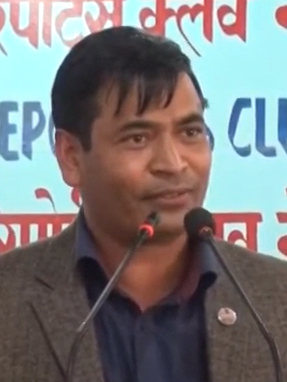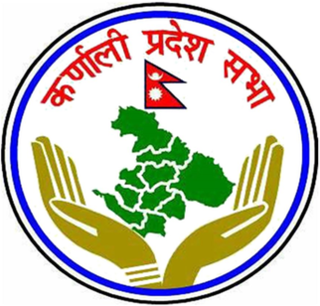Related Research Articles

The Nepali Congress is the oldest democratic socialist political party in Nepal and the largest party in the country. The party has 870,106 members as of the party's 14th general convention in December 2021 making them the largest party by membership in Nepal. In June 2023, the party started online membership since the emergence of youth leaders in vital post to bring youths into the party. The party is led by former prime minister, Sher Bahadur Deuba since the party's thirteenth general convention in 2016. The party won 89 seats in the 2022 general election and is currently the largest parliamentary group in the House of Representatives.
Tilak Pariyar is a Nepalese politician currently serving as the Governor of Karnali Province. He was appointed Governor, as per the Article 163 (2) of the Constitution of Nepal by the President Bidya Devi Bhandari on the recommendation of the Council of Ministers of the Government of Nepal on 9 November 2021. He previously served as the 2nd Governor of Province No. 2 of Nepal. He is former member of the 1st Nepalese Constituent Assembly from Banke-1 constituency.

Gandaki Province ), is one of the seven federal provinces established by the current constitution of Nepal which was promulgated on 20 September 2015. Pokhara is the province's capital city. It borders the Tibet Autonomous Region in Southwest China to the north, Bagmati Province to the east, Karnali Province to the west, and Lumbini Province and Bihar of India to the south. The total area of the province is 21,504 km2 - constituting 14.57% of Nepal's total area. According to the latest census, the population of the province was 2,479,745. The newly elected Provincial Assembly adopted Gandaki Province as the permanent name by replacing its initial name Province No. 4 on 27 April 2023. Surendra Raj Pandey is the present chief minister of Gandaki Province.

Karnali Province is one of the seven federal provinces of Nepal formed by the new constitution, which was adopted on 20 September 2015. The total area of the province is 27,984 square kilometres (10,805 sq mi), making it the largest province in Nepal with 18.97% of the country's area. According to the 2011 Nepal census, the population of the province was 1,570,418, making it the least populous province in Nepal. The province borders the Tibet Autonomous Region of China to the north, Gandaki Province to the east, Sudurpashchim Province to the west, and Lumbini Province to the south. Birendranagar with a population of 154,886 is both the province's capital and largest city.

The provinces of Nepal are governed by provincial governments which form the second level of governance in the country; after the federal government. The provincial governments are established, and their structure is defined by Part 13 of the Constitution of Nepal.

Mahendra Bahadur Shahi is a Nepalese politician and former Chief Minister of Karnali, a province in western Nepal. He was member of the 1st Nepalese Constituent Assembly and as Minister of Energy, Nepal. He was unanimously selected as the Parliamentary Party leader of the CPN (MC) for Karnali on 14 February 2018.

In the Federal Democratic Republic of Nepal, a governor is the constitutional head of each of the seven provinces. Sub-Article 1 of Article 163 of the Constitution of Nepal says that the Governor is a representative of the Government of Nepal in each province. The governor is appointed by the president of Nepal recommended by federal cabinet for a term of five years and holds office at the president's pleasure. A person who has once served as the governor of a province cannot be appointed to the same post twice. The governor is de jure head of the provincial government; all its executive actions are taken in the governor's name. However, the governor must act on the advice of the popularly elected council of ministers, headed by the chief minister, which thus holds de facto executive authority at the province-level. The Constitution of Nepal also empowers the governor to act upon his or her own discretion, such as the ability to appoint or dismiss a ministry, recommend president's rule for the president's assent.

The Minister of Health and Population is the head of the Ministry of Health and Population. One of the senior-most officers in the Federal Cabinet, the minister is responsibility for overall policy formulation, planning, organisation and coordination of the health sector at national, province, district and community levels. The Minister is assisted by the Minister of State for Health and Population and the junior Deputy Minister of Health and Population.
Events in the year 2021 in Nepal.

In Nepal, the chief minister is the elected head of government of each of the seven provinces. The chief minister is appointed by the governor of the provinces according to Article 167 of the Constitution of Nepal.
The chief minister of the Gandaki Province is the head of government of Gandaki Province. The chief minister is appointed by the governor of the province according to Article 167 of the Constitution of Nepal. The chief minister remains in office for five years or until the provincial assembly is dissolved, and is subject to no term limits, given that they have the confidence of the assembly.

The chief minister of the Karnali Province is the head of government of Karnali Province. The chief minister is appointed by the governor of the province according to Article 167 of the Constitution of Nepal. The chief minister remains in office for five years or until the provincial assembly is dissolved, and is subject to no term limits, given that they have the confidence of the assembly.
Parashuram Khapung (Limbu) is a Nepalese politician and current Governor of Koshi Province. He was appointed Governor, as per the Article 163 (2) of the Constitution of Nepal by the President Bidya Devi Bhandari on the recommendation of the Council of Ministers of the Government of Nepal on 11 November 2021. He is a former member of House of representatives.
The chief minister of the Madhesh Province is the head of government of Madhesh Province. The chief minister is appointed by the governor of the province according to Article 167 of the Constitution of Nepal. The chief minister remains in office for five years or until the provincial assembly is dissolved, and is subject to no term limits, given that they have the confidence of the assembly.

The Governor of Madhesh Province is the nominal head of state of the Nepal state (province) of Madhesh Province and a representative of the President of Nepal. The governor is appointed by the term president for a term of five years. The governor's powers are mostly ceremonial and the executive powers of the governor are exercised by the chief minister of Madhesh Province, who is the head of the executive of the state government of Madhesh Province. The following is a list of governors of Madhesh Province.
The governor of Koshi Province is the nominal head of state of the Koshi Province of Nepal and a representative of the President of Nepal. The governor is appointed by the President for a term of five years. The governor's powers are mostly ceremonial and the executive powers of the governor are exercised by the chief minister of Koshi Province, who is the head of the executive of the state government of Koshi Province.

The Government of Koshi, known locally as the Provincial Government, is the supreme governing authority of the Koshi Province which consists of 14 districts.

The Minister of Industry, Commerce and Supplies is the head of the Ministry of Industry, Commerce and Supplies. One of the senior-most officers in the Federal Cabinet, the minister is responsibility to create a favorable environment for industrial development and investment promotion. The minister has also expressed his involvement in formulating policies and programs related to industry, commerce and supply and in frugal cooperation and exchange with various ministries and agencies of the Government of Nepal.

The Minister of Agriculture and Livestock Development is the head of the Ministry of Agriculture and Livestock Development. One of the senior-most officers in the Federal Cabinet, the minister responsible for growth and development of agriculture and livestock sector is an ex-officio member of Nepal Agricultural Research Council, Nepal Veterinary Council and National Tea and Coffee Development Board. The Minister is assisted by the Minister of State for Agriculture and Livestock Development and the junior Deputy Minister of Agriculture and Livestock Development.
The Governor of Sudurpashchim Province is the nominal head of state of the Sudurpashchim Province of Nepal and a representative of the President of Nepal. The governor is appointed by the President for a term of five years. The governor's powers are mostly ceremonial and the executive powers of the governor are exercised by the chief minister of Sudurpashchim Province, who is the head of the executive of the state government of Sudurpashchim Province.
References
- ↑ "Know how much a minister, an MP and other high officials earn in Nepal". Online Khabar . 7 September 2021. Archived from the original on 7 September 2021. Retrieved 7 September 2021.
- ↑ "Part -13 State Executive – Nepal Law Commission" . Retrieved 2020-06-05.
- ↑ Article Schedule 6 of the Constitution of Nepal (September 20, 2015)
- ↑ Article Schedule 9 of the Constitution of Nepal (September 20, 2015)
- ↑ Service, Himalayan News (2021-11-10). "Three provinces have new governors". The Himalayan Times. Retrieved 2023-08-05.
- ↑ "New governors to be appointed for Province 1, Karnali and Sudur Paschim". My Republica. Retrieved 2023-08-05.
- ↑ Republica. "Newly-appointed provincial governors sworn-in". My Republica. Retrieved 2023-08-05.
- ↑ Thapa, Richa (2018-01-19). "President to administer oath of office to newly appointed guvs at 4:00 pm". The Himalayan Times. Retrieved 2023-08-05.
- ↑ Sureis (2019-11-04). "Governors of all seven provinces sacked". The Himalayan Times. Retrieved 2023-08-05.
- ↑ Poudel, K. P. "प्रदेश प्रमुख पदको पद तथा गोपनियताको शपथग्रहण". www.presidentofnepal.gov.np (in Nepali). Archived from the original on 2020-06-05. Retrieved 2020-06-05.
- ↑ "President administers oath of office to newly-appointed governors". The Himalayan Times. 2019-11-05. Retrieved 2020-06-05.